When The Chips Are Down: Making Cents of Data Sheets (Guest Blog)
By Ben Winslow On 10/11/2021
So you finally got that specialty hardware vendor to give you a data sheet on the chipset they use. Now what?
Perhaps you got lucky and your contact at the vendor you are working with got you the documentation you asked for right away, or, (more likely) you pestered them until they put you in touch with their vendor, and then they found you someone who understood what you were asking for. Now that you've got the datasheet you can finally get started on designing an awesome Wi-Fi network for this super-critical client!
The problem now is that you've opened this 80 page PDF, and you can't make heads or tails of it...
Let's take a few steps back first, in case you were dealt a bad hand and don't have any documentation yet. There are a handful of resources that put this documentation within reach of anyone with internet access. You may need to do a lot of googling, but with persistence, you can usually find some breadcrumbs which will lead you in the right direction.
Every wireless emitting device sold in the USA is required to have an FCC ID. Approved transmitters that are certified as modules must be labeled with their FCCI ID directly on them. Devices that contain non-certified transmitters may be granted authorization, in which case the FCC ID label must be placed on the exterior of the finished product.
If you have the FCC ID of the device in question, you can search the database at FCCID.io. This may yield many documents to sift through, but right off the bat, the device's page should provide you with the operating frequencies and transmit power for each.

In addition to the frequencies and power output, you will find the grant notes section might offer some insight into the device's capabilities. You can click on these notes to investigate further, but for instance, the above code MO signifies MIMO evaluation of the device, and code ND signifies compliance with TPC (Transmit Power Control) and DFS (Dynamic Frequency Selection) requirements set forth by the FCC.
Scrolling down a bit will bring you to the Exhibits section where you can find a trove of documents such as photos taken during testing of the device, test reports, legal documents, photos of the inside & outside of the device, the FCC ID label, user manuals, and datasheets.
This can be a lot to sort through, but generally, the user manual or datasheet (if listed) will prove the most useful. You might also find propagation patterns depicting the shape of the signal as measured during the testing. This may help to determine if the module or device is installed/deployed in a sensible orientation.
If your search brought you to user manuals of a different device, or the manual does not provide sufficient detail for your purposes, we can go another layer deeper.
The websites https://wikidevi.wi-cat.ru/ & en.techinfodepot.shoutwiki.com boast powerful search capabilities and can lead you to some very detailed and useful information regarding client devices. You can search for a brand, manufacturer, model number, chipsets, and individual chips to find devices that use those chips or chipsets. In searching other devices which use the same chips, you may infer that they have the same chipset, and documentation for one may relate to the other. This should not be taken as gospel, but if there is absolutely nothing else available, it may point you in a general direction.
On the wiki page for an adapter or embedded system, you will find oodles of information about a device. There is a nice synopsis on the right-hand side and more detailed information at the bottom of the page.
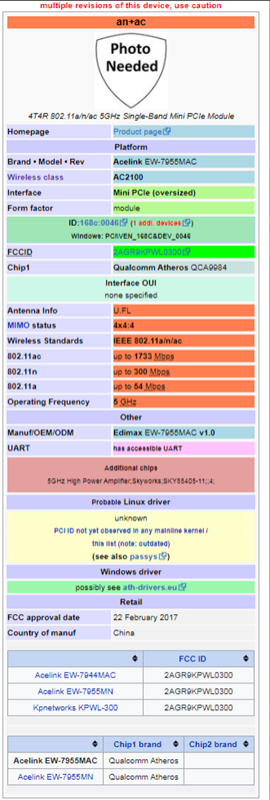
Device Details for Acelink EW-7955MAC adapter from en.techinfodepot.shoutwiki.com

Device details for SeeedStudio BeagleBone Green Gateway from en.techinfodepot.shoutwiki.com
If you still do not have enough information for your purposes or have not found a datasheet, you will need to do some more digging. You can look for a datasheet of the individual chips listed on these websites, or search for chip 1 & chip 2 together to try and find the actual "set".
You can search the chip manufacturer's website or electronics vendors/distributors, a few I have found success with are arrow.com, alldatasheet.com, datasheet.es, datasheetcatalog.com, but it's a bit of a coin toss.
Your mileage may vary with any given resource, and I will spare the reader any lengthy methodology for using search engines.
Let's fast forward (or rewind) - you now have a datasheet in front of you. Data Sheets come in all shapes and sizes, and the level of detail that you find in one may not be available in another. The type of parts, number of integrated components, and capabilities will determine the length and information contained.
The first page generally offers a description of the device, key features, applications/use-cases, and will usually show a functional block diagram that maps the inputs, outputs, and logical flow of functions and components on the chipset.
This high-level view may be enough to determine if a client device will suit your needs, or meet the standards of your enterprise environment. For instance, the features section will likely reveal supported bands, QoS support, and authentication capabilities.
In the example below, we see that the device is only 2.4 GHz capable, and only supports personal modes of WPA/WPA2 authentication, though it does offer WMM, WMM-PS, and Wi-Fi Voice Personal QoS capability. The description notes that this chip is well suited for the integration of IoT applications and handheld wireless systems. It describes features and technologies which make it a good choice for highly mobile devices with power constraints and small form-factors.
If you find that a vendor has implemented/integrated a chipset in a method that greatly differs from the datasheet's suggested use-case, it might be worth investigating or inquiring as to why the chipset was chosen. You may also consider asking for case studies of other businesses which have had success with their solution, and validating with the customer if they will disclose that information.
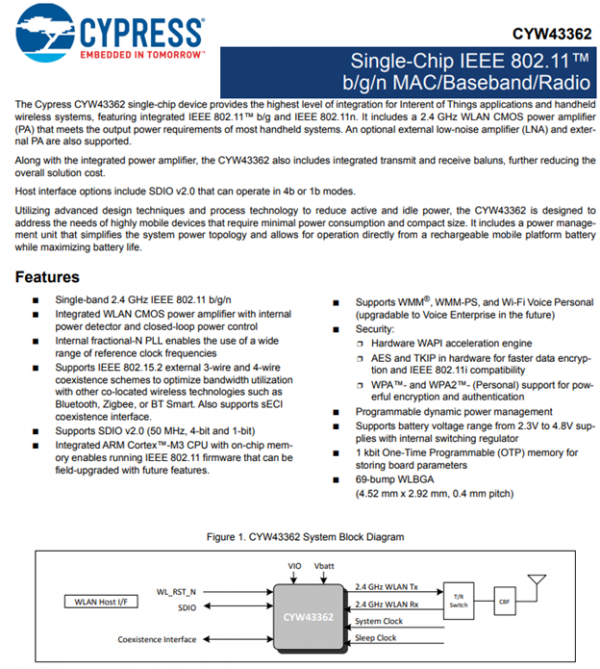
Soon after this summary, you should find a pinout diagram. This may not seem all that relevant to someone that is not directly involved in building the equipment or machine, but knowing that it is there and what to look for can be incredibly useful. You may find yourself troubleshooting some bizarre or inexplicable behavior from a wireless client, which may be the result of connections made to the wrong pins.
The pinout diagram will number each connection on the chipset, and map it to its function either on the same page or on the flowing pages with descriptions for each pin or lead. The antenna pins may likely be of the most interest to you, especially if they are labeled as primary/auxiliary, or are different for different bands/frequencies. On a chipset with non-symmetrical Tx/Rx radio chains (ie; 2x1:1 or 3x2:2), this could be a pain point if external antennas are implemented by engineers that are not well versed in RF communications.
Pinout diagrams may look very different from one datasheet to the next, and they may seem intimidating, but after looking at a few, and knowing what you are looking for, it really isn't all that complicated.
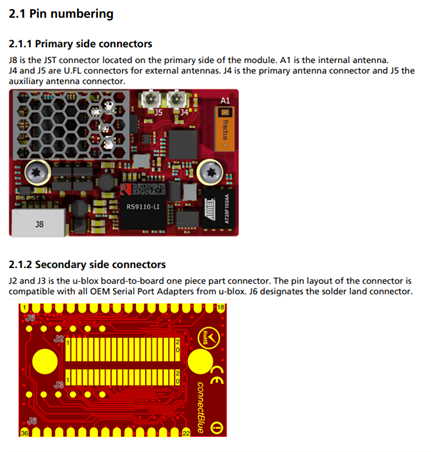
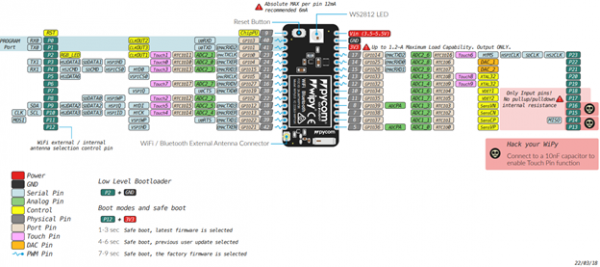
Following pinout diagrams and associated descriptions are likely to be followed by electrical specifications, circuit characteristics, power consumption and tolerances, processing clock rates, and environmental characteristics/tolerances. Of these, the environmental characteristics may be of the most interest to you, especially if the device will be operating in any harsh conditions with extreme heat or cold.
Finally, we get to the WLAN/RF Specifications section. You may find another block diagram with more detail on the functions specifically pertaining to wireless communications. In this section, specific standards which the chipset complies with should be listed, such as 802.11i/k/v/r/w, etc.
Receiver and Transmitter performance specifications should be listed for each band supported. Here you will find receive sensitivity ratings for each supported modulation scheme on each band. This will tell you what your minimum RSSI (as measured by the device) must be to achieve each data rate. This should also list the maximum signal strength that the chipset can receive without causing damage.
These tables can also take many different shapes and levels of complexity. But they should all tell you what the RSSI and Tx power requirements are for supported MCS/data rates on each band/PHY.
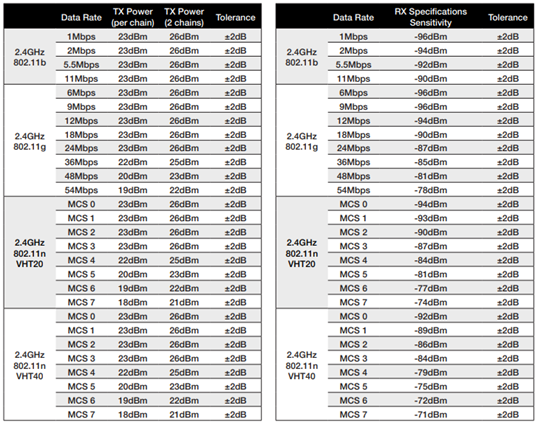
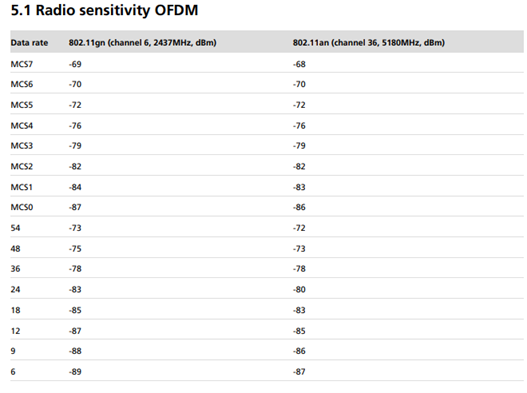
The transmitter section should also provide clarification on the maximum transmit power that the chipset is capable of on any given frequency. This will allow knowing what the maximum transmit power you might want to set your APs to transmit at.
On more detailed documents, you may see some intimidating transmit power tables, I will try to break some of the fields down for you. You may also find power values that seem to be quite low. The table below describes the characteristics of a chip's output without an external PA (Power Amplifier).
Of most relevance, the following symbols/definitions will help make sense of this table.
Ftx: The range of frequencies that the device can operate on.
Pout: Output power, calculated after the determination of Input Power (Pin) and DC power consumption of components.
EVM: Error Vector Magnitude. This measures accurately the wireless system transmits symbols within a constellation. EVM measures the quality of a transmitter or receiver by identifying sources of signal degradation. Think of this as tolerance for noise in an electrical system or environment, or a standard deviation from the ideal vs reality.
SPgain: This is the size of each "step" the device can take in increasing or decreasing the transmission gain, in dB. In the table below, the chip can only increase or reduce signal strength in values of .5 decibels.
A great slide deck on some of these concepts can be found at: http://rfic.eecs.berkeley.edu/ee242/pdf/Module_6_1_PA_Sys.pdf
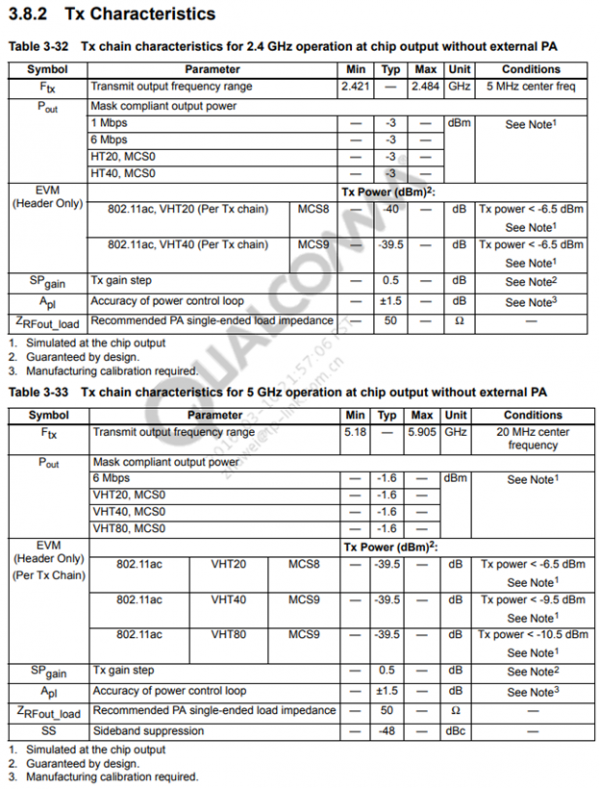
Every datasheet will be different, though a manufacturer may likely stick to a consistent format, it is likely that you will end up working with many different manufacturers if you stick around for a bit. Familiarizing yourself with the contents of these documents, and understanding what they can tell you about a wireless chipset (or any electronic device) will benefit you greatly, if even just for appreciating the complexity of the technology that you work with.
The order in which this information is presented is not necessarily how it may appear in the datasheet you are referencing, but hopefully, it will help you find what information you are looking for.
Twitter: @WiFi_Ben
https://red7wireless.com/
Tagged with: data sheet, chip set, vendor, Wi-Fi, wireless
Blog Disclaimer: The opinions expressed within these blog posts are solely the author’s and do not reflect the opinions and beliefs of the Certitrek, CWNP or its affiliates.



